In the painting I call “Toucan Fly,” I began as usual by thinking about and planning what I wanted to describe about the toucan and my experience of it. From my workshop in Costa Rica last February, I had several digital photos of the wonderful Chestnut-Mandibled Toucan in one of its favorite trees, the Corcopia (I think). My painting would describe the bird’s story in its habitat and include the following:
- The light through the backlit leaves as I looked up into the tree.
- The toucan, ready to fly, almost hidden in the leaves.
- The distant toucan, sitting brightly against the coastal jungle.
- The moist and sunny air.
- The shaded leaves on the lower branches of the Corcopia tree.
Starting “Toucan Fly”
In my sketchbook, I made a value/composition study using a black Prismacolor pencil. I dated the sketch and gave it a working name to help keep my overall intention in mind as I progressed.
I found myself playing with a circular reference that included both toucans. I liked it. But I felt I needed more study for this complex painting.
My studies are my roadmaps and help prevent the terror of beginning! I wanted to clarify how I could portray both the distant toucan and the close one, as well as the light at the top of the tree and shade below that I had experienced in Costa Rica.
I did a quick watercolor study on the next page of my sketchbook. The color sketch showed me that to “hide” the close toucan I would need to use similar shapes and colors in the upper leaves. Now, where to begin?
Steps 1 through 3
I drew the sketch fairly roughly on Fabriano Artistico watercolor paper and started with an all over wash of Yellow (Aureolin for its transparency) at the top for the sun and lavender (Rose Madder Genuine mixed with Cobalt blue) at the bottom for the distant coastal mountains.
Then, keeping my concepts clear, I began playing, leaf by leaf at the top, experimenting with colors and techniques. I worked with the leaves in the sun, wetting a leaf first with yellow and then adding in other colors —like Cobalt Blue for the reflected sky and Quinacridone Gold and Quinacridone Sienna for backlit effects—letting some mix wet in wet, applying others to dry paper. Much later I would come back with some dark greens.
I was eager to get to the toucan so I could work it into the entire design. Suddenly, after putting in the straight tail from a photo, I remembered to refer to my studies—and about the circle design concept. Oops. I would have to curve the tail to reinforce the circle concept.
Step 4
I lifted as much of the toucan tail as I could and lengthened and curved the end, disappearing beyond leaves. Okay. I noted that I had achieved a color scheme in these first pigment choices.
- Aureolin Yellow—for glazing and transparency and greens
- Cobalt Blue—for glazing, transparencies, greens and sky reflections
- Rose Madder Genuine—for glazing and mixing with blue for lavenders
- Quinacridone Sienna—for bright, intense oranges of backlighting
- Quinacridone Gold—to mix with blues for wonderful greens and for backlighting
- Ultramarine Turquoise—to mix with Quinacridone Sienna for great greens and alone for shaded leaves
- Nickel Azo Yellow—for surprise in wet mixes and because I love it!
- Naphthamide Maroon—to mix with Ultramarine Turquoise for black and to use for a few dark finishes
- Cerulean Blue— a cool, opaque blue to suggest distance
I continued leaf by leaf and shape by shape, placing most of the oranges and bright yellows at the top near the toucan’s yellow and orange beak. I painted in the yellow and black shape of the faraway toucan, putting it in first to locate the distant branch that would continue the circle. And, I painted in more shaded leaves near the bottom using Ultramarine Turquoise alone and with Quinacridone Sienna for dark greens and Nickel Azo Yellow for surprise blends!
Step 5 – Adolescence
To suggest distance and spotlight the faraway toucan, I added the purple mountain and suddenly saw I was in “Adolescence” – seeing all the things I didn’t like and very few that I did!
I stood back, got out my sketchbook and took some notes. What was working and what was not?
I still liked the overall idea and colors—but the circle wasn’t clear, my eyes jumped around an awful lot and I needed to anchor the painting so that it didn’t just “fly away”! Also, the diagonal purple of the mountains seemed too strong, taking too much attention away from the circle. I also seemed to have covered up my “trail of light” that subtly connected the two toucans.
I reminded myself that this wasn’t the time to scrub things out or throw it all away. It was time for real work — solving problems by adding.
Step 6
To soften the diagonal, I put in a distant mountain shape with Cerulean Blue and began to add smaller dark leaves in scale to the distant bird.
Then, without thinking, I made a huge mistake. I extended a leaf and the toucan’s tail wound up going through it. Uh oh.
Repeating to myself, “I can fix anything”, I added a yellow leaf shape to resolve the tail issue, added more dark leaves at the bottom and decided that next I needed to reinforce the circle– and hopefully, finish up.
Finishing
To finish, I asked my students and fellow painters for a critique and agreed with several observations. In response I added more darks at the bottom, which helped balance the dark feathers near the top and also reinforced the lighter circular reference.
The other things I did are very subtle – breaking the distant mountain edge against the sky and lifting a bit between leaves to create a very subtle “path of light” down to the distant toucan.
Finally, I applied an all over pale cobalt blue wash over the yellow sky. This seemed to soften and humidify the atmosphere and accentuate the yellows!
This painting was exceedingly complex and required more attention to color relationships than most of my prior paintings.
In the end, my finishing touches went back to the original ideas – the circle, the idea of sunlight at the top and shade at the bottom and accentuating the foreground bird’s disguise in its habitat.
Now that I’m finished, I love it.
Materials List:
- Daniel Smith Extra Fine™ Watercolors
- Aureolin Yellow
- Cobalt Blue
- Rose Madder Genuine
- Quinacridone Sienna
- Quinacridone Gold
- Ultramarine Turquoise
- Nickel Azo Yellow
- Naphthamide Marroon
- Cerulean Blue
- Ultramarine Blue
- Lunar Earth
- Buff Titanium
- Iridescent Gold
- Fabriano Artistico Watercolor paper
- Daniel Smith Platinum Series 24-2 1″ Flat Watercolor Brush

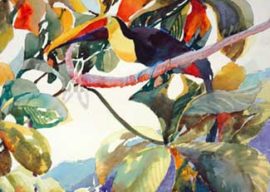
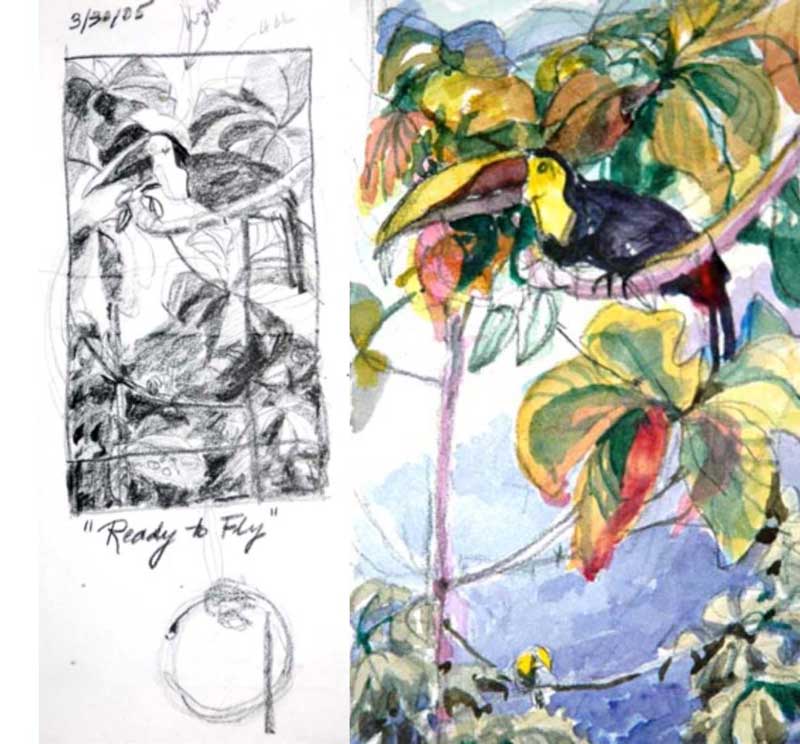

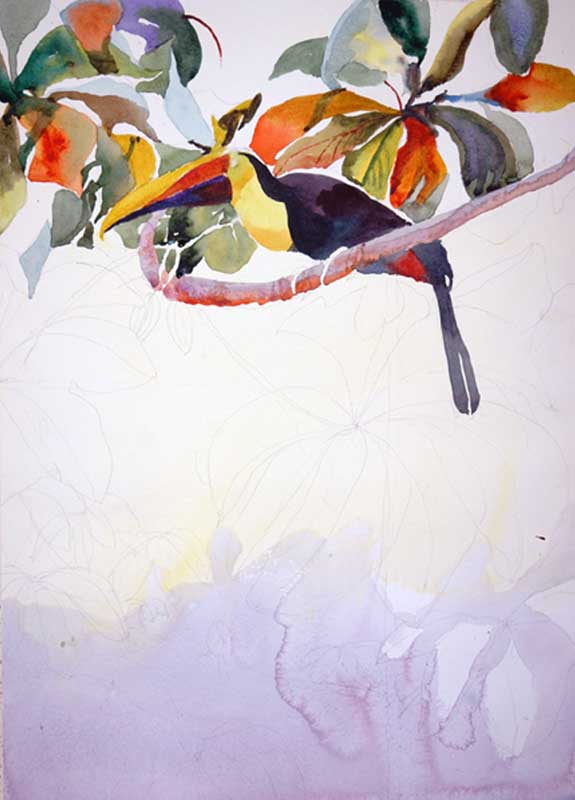
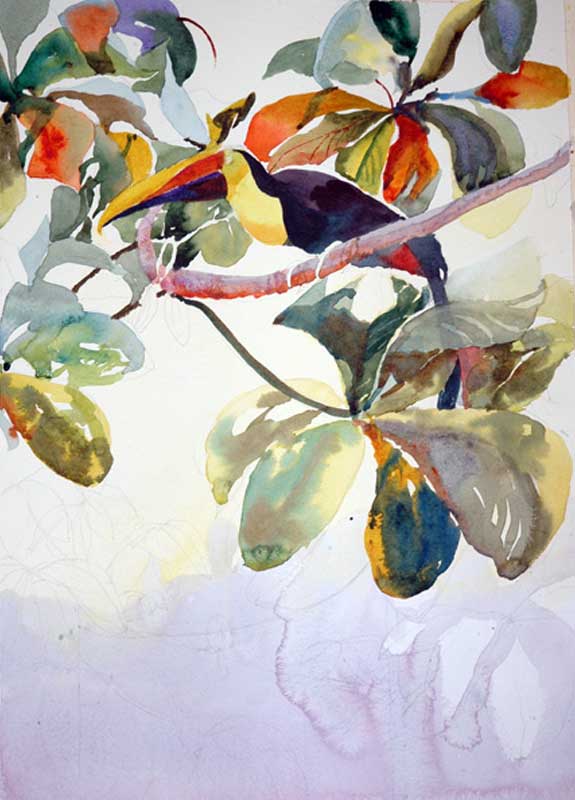
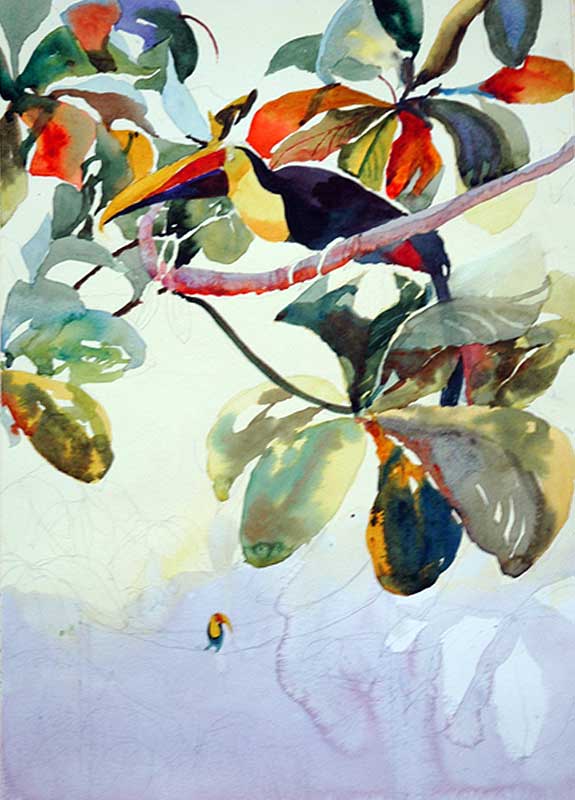

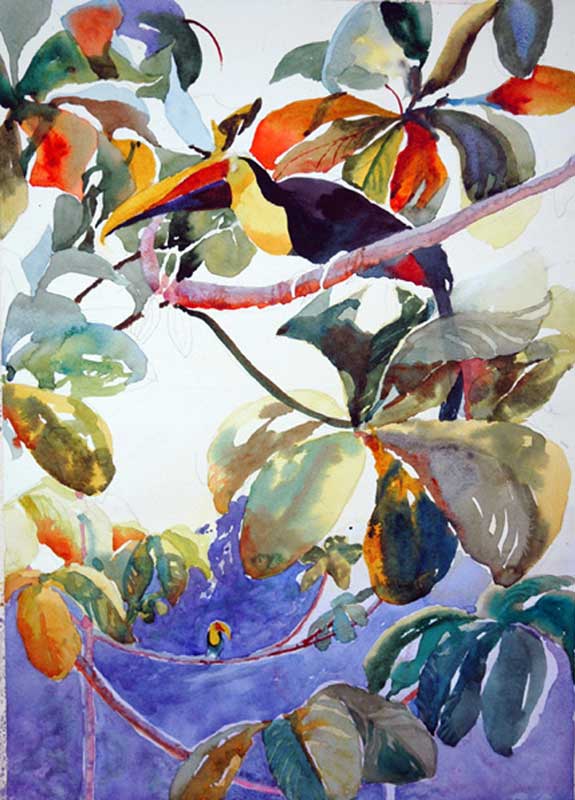
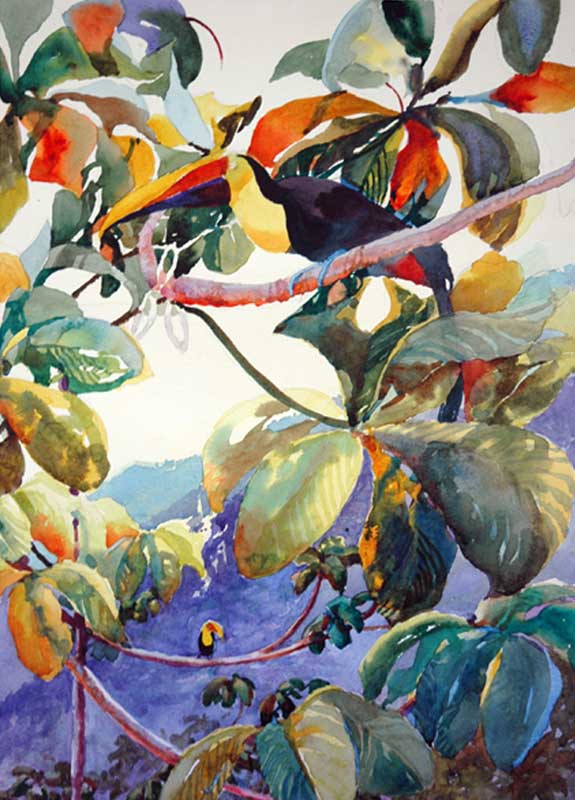
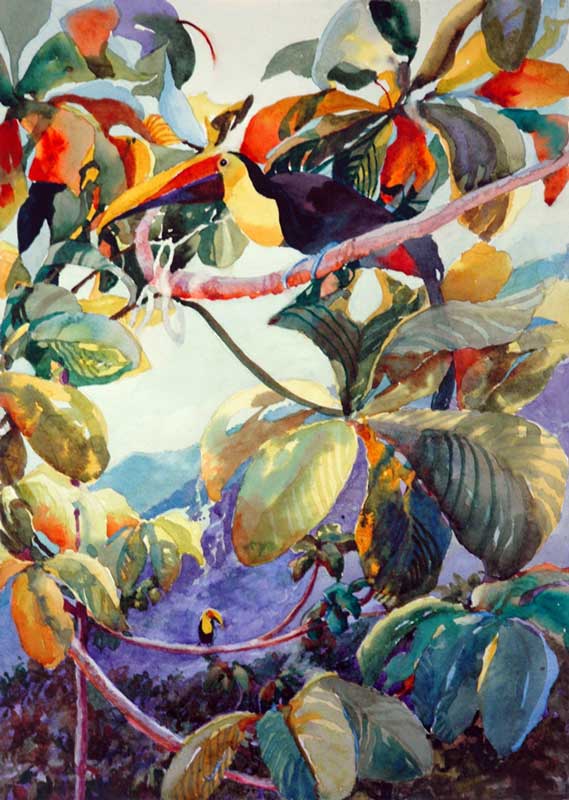

hello Jan,
Great commentary about dealing with the angst of starting a painting. I thing yours was the first long class I took thru SCVWS about 5/6 years ago and i still remember your positive attitude and raw talent. I have used your book as a constant color reference and I hope I get it back when I loan it out to fellow painters. I just posted my first painting on my facebook page; I really hate facebook but it gets me lot of pictures of my kids and grandkids.
Best
Alan
Good to hear from you Alan – and happy that you are still finding my book useful. Send me a friend request so I can see your Facebook page – and I know what you mean about some of FB, but it is a wonderful way to stay connected! Thanks for posting and keep up the good work!
Hi Jan,
Love this painting. The colors and the beauty of the jungle are breathtaking. Thank you for your notes on the development of the painting.